Autism's Effects On The Brain

Understanding Autism Through Brain Science
Autism Spectrum Disorder (ASD) is a complex neurodevelopmental condition characterized by diverse cognitive, social, and behavioral features. Advances in neuroimaging, genetics, and molecular biology have begun to unravel how autism affects brain structure and function, providing a comprehensive picture of its neurobiological underpinnings. This article explores the developmental, structural, connectivity, and functional alterations in the autistic brain, highlighting recent research findings that shed light on the mechanisms driving the spectrum.
Widespread Molecular and Structural Brain Differences in Autism
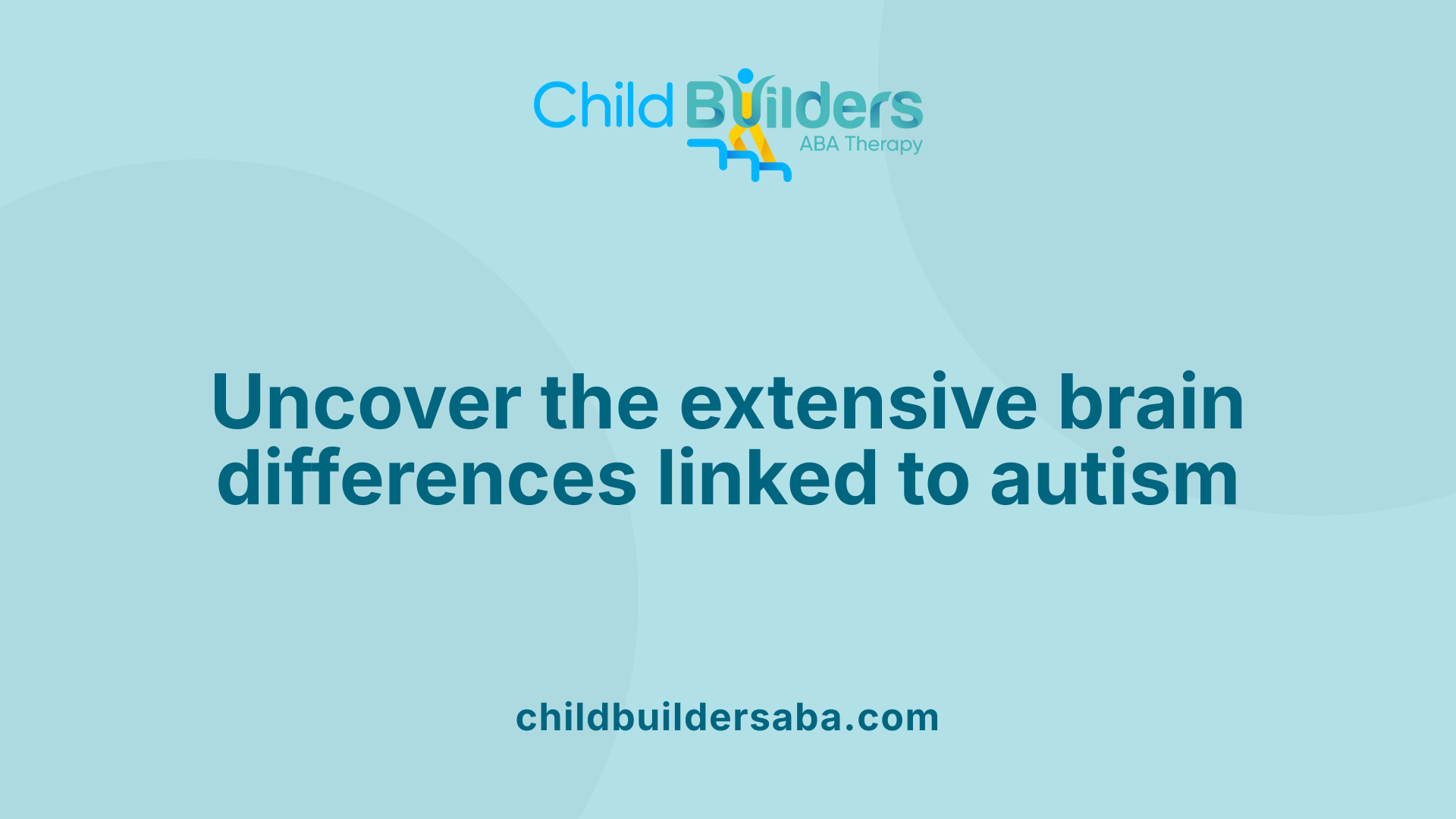
How does autism affect brain function related to social and emotional processing?
Autism spectrum disorder (ASD) significantly impacts neural circuits responsible for social and emotional functions. Key brain regions involved in these processes, such as the amygdala, prefrontal cortex, anterior cingulate cortex, and insula, show atypical activity and connectivity patterns in autistic individuals.
Neuroimaging studies reveal that children and adults with ASD often exhibit reduced activation in areas associated with emotion regulation and social understanding during relevant tasks. For instance, the dorsolateral prefrontal cortex, essential for emotional reappraisal and control, shows decreased responses, impairing the ability to manage feelings and interpret social cues effectively.
Furthermore, the limbic system, including the amygdala, shows altered responses to emotional stimuli, which hampers the recognition and expression of emotions. This neural disruption makes it challenging for individuals with ASD to interpret facial expressions, vocal tones, and other social signals, leading to difficulties in social communication and interaction.
Connectivity analyses support these findings, showing that the typical integrated activity across social brain networks is compromised in ASD. As a result, the impaired communication between regions involved in social cognition and emotion underlies many of the core behavioral symptoms observed, such as difficulty in bonding, understanding others' emotions, and responding appropriately.
In summary, autism influences brain function related to social and emotional processing by disrupting the normal activity and interaction of specialized neural substrates, contributing to the social deficits and affective difficulties characteristic of the condition. This neural basis underscores the importance of targeted therapies aiming to enhance connectivity and function within these critical regions.
Neuroimaging Insights Into Brain Development and Abnormal Growth Patterns
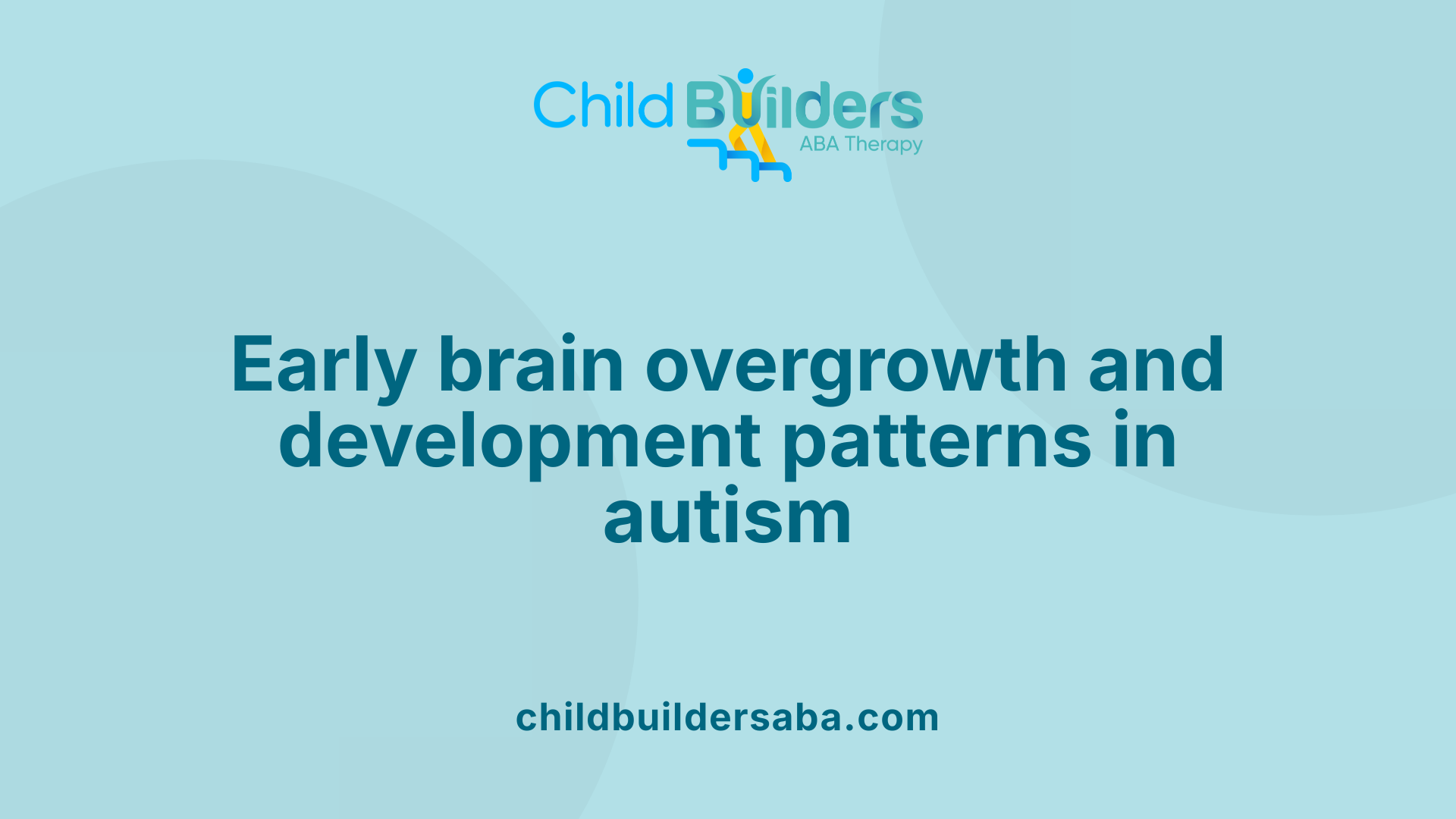
What does neuroimaging research reveal about the brains of individuals with autism?
Neuroimaging studies have significantly advanced our understanding of how the autistic brain develops differently from typical development. These investigations employ various imaging techniques, such as MRI, diffusion tensor imaging (DTI), and functional MRI (fMRI), to examine structural and functional aspects of the brain.
One of the most consistent findings is evidence of early brain overgrowth in children with autism. This rapid expansion predominantly occurs within the first two years of life and involves increases in overall brain volume and specific regions such as the cerebral cortex, cerebellum, and limbic structures. The early phase of overgrowth is characterized by an accelerated increase in cortical surface area, especially in the frontal, temporal, and parietal lobes, which are key areas involved in cognition, social processing, and language.
However, this rapid development is often followed by a plateau or even a decline in growth rates during later childhood and adolescence. In some cases, brain volume growth appears to arrest or slow significantly after ages 10-15, suggesting that initial overgrowth may disrupt typical maturation trajectories.
Structurally, neuroimaging reveals that individuals with autism tend to have differences in grey matter volume, white matter integrity, and cortical thickness. Regions such as the amygdala, corpus callosum, and areas within the frontal and temporal lobes show consistent abnormalities. For example, some studies report increased volume in the amygdala during early childhood, which may relate to social and emotional processing difficulties.
White matter abnormalities, detected through DTI, indicate altered connectivity pathways, including both increased and decreased fiber integrity in various tracts. These variations can interfere with neural communication, impacting social behaviors and information processing.
Functional neuroimaging studies show altered patterns of activity and connectivity in networks involved in social cognition, language, and sensory processing. For instance, atypical activation in the superior temporal sulcus and the right inferior frontal gyrus correlates with social communication deficits. Resting-state fMRI highlights disruptions in large-scale networks like the default mode network (DMN), which is crucial for self-referential thought and social understanding.
Moreover, genetic factors influence brain morphology. Mutations in genes such as HOXA1, associated with increased head size, and PTEN, linked with overgrowth, demonstrate the genetic basis of some neuroimaging-observed structural differences.
These brain imaging findings demonstrate that autism involves complex, age-dependent changes in brain structure and function. The overgrowth in early childhood, combined with subsequent developmental divergences, forms a neurobiological foundation underlying the behavioral and cognitive features of ASD.
In summary, neuroimaging research reveals that autism is characterized by distinct developmental trajectories. Early accelerated growth impacts the organization and connectivity of brain regions involved in social, emotional, and cognitive functions, while later stages show alterations in brain volume and neural network integration, all contributing to the wide spectrum of autism symptoms.
| Aspect | Typical Development | Autism Spectrum | Notes |
|---|---|---|---|
| Early brain growth | Steady, gradual increase | Rapid overgrowth in first 2 years | Significant early cortical expansion in ASD |
| Brain volume in childhood | Stable or slowly increasing | Accelerated increase, then arrest | Linked with cognitive and social development |
| Cortical surface area | Balanced expansion | Excessive expansion before age 2 | Affects areas involved in higher cognition |
| Cortical thickness | Consistent during childhood | Variations observed | Disrupted maturation trajectories |
| White matter integrity | Organized tracts | Atypical connectivity, both increased and decreased | Influences neural communication |
| Amygdala volume | Normal development | Enlarged in early years | Related to emotional and social challenges |
| Network connectivity | Typical integration | Hypo- or hyper-connectivity | Affects social and cognitive processing |
Understanding these neuroimaging findings guides ongoing research and potential interventions aimed at targeting early developmental windows and neural pathways involved in ASD.
Developmental Timeline and Critical Periods in Brain Morphogenesis
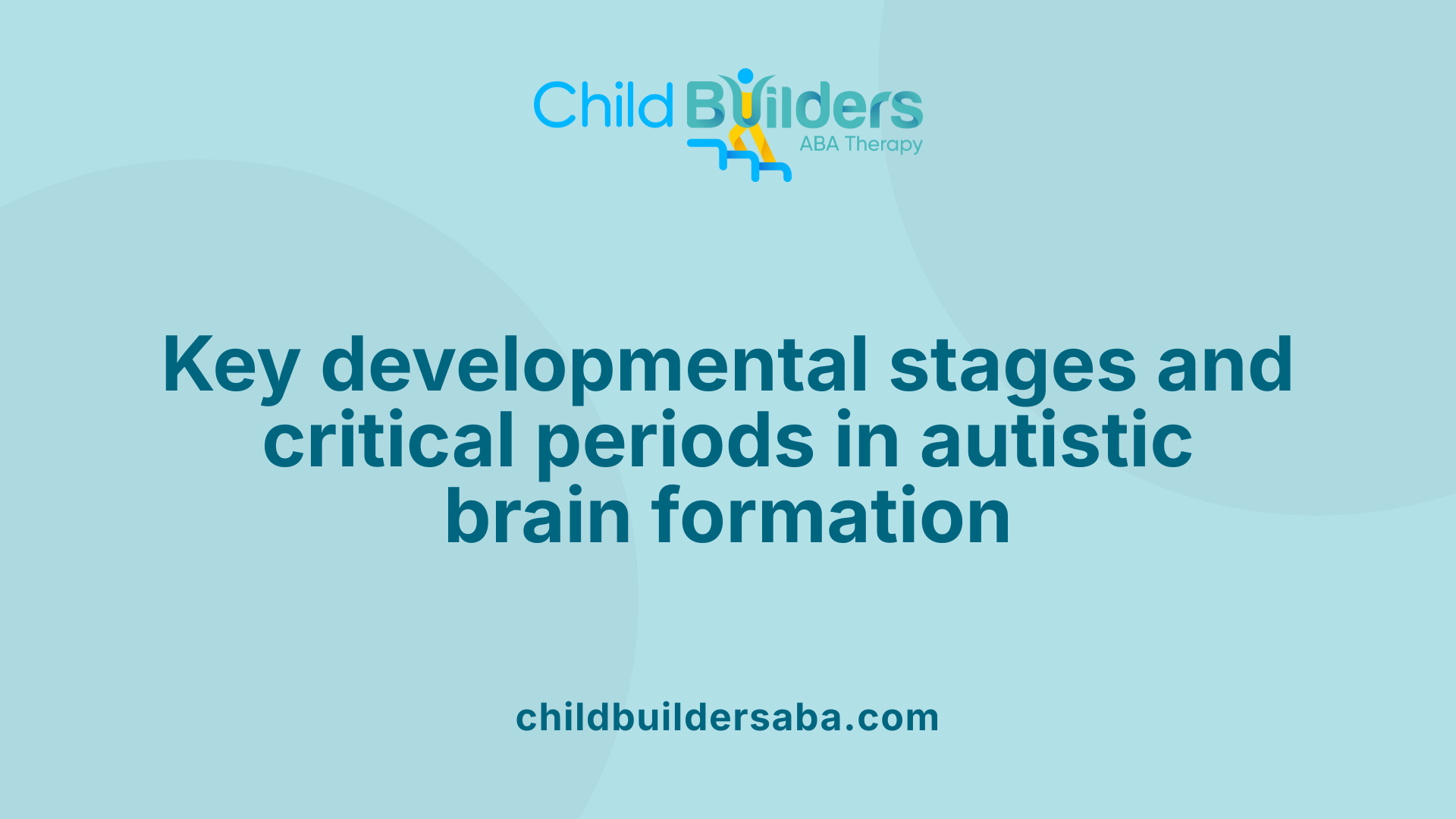
At what developmental stages do brain differences become evident in autism?
Brain differences in autism are detectable very early in development, often within the first year of life. Modern brain imaging techniques, such as MRI scans, have revealed that atypical brain growth patterns can be observed as early as 6 months of age. These early signs include increased brain volume, particularly in structures like the cerebral cortex, cerebellum, and limbic areas.
Between 6 and 24 months, structural changes become more pronounced. During this crucial period, there is often an observed pattern of accelerated growth followed by slowing or arrest in growth rates. For example, children with autism frequently show early overgrowth of the brain, especially in regions tied to higher cognitive functions, social behavior, and language. This overgrowth coincides with the emergence of behavioral symptoms such as motor delays, atypical eye gaze, and difficulties in social engagement.
Molecular studies support these neuroimaging findings. They suggest that differences in gene expression—particularly in visual, parietal, and frontal cortices—may underpin the initial structural alterations. These molecular modifications involve genes related to neuronal connectivity, inflammation, and synaptic function.
As children grow older, these early structural anomalies influence the development of neural connectivity patterns. Changes in white matter tract integrity and synaptic density are evident and evolve through childhood and adolescence. In particular, abnormalities like altered cortical gyrification, regional cortical thickness differences, and disrupted neural network connectivity become more apparent.
Importantly, the formation of neural circuits occurs during specific critical periods, during which the brain is especially moldable. Disruption during these times—such as abnormal synapse formation, altered timing of neural activity, or immune-related inflammation—may contribute to the core features of autism.
Overall, neurodevelopmental differences in autism start in infancy, with significant early changes detectable within the first 6 months. These differences continue to evolve, highlighting the importance of early detection and intervention during these sensitive periods of brain circuit formation and maturation.
Alterations in Brain Connectivity and Network Functioning
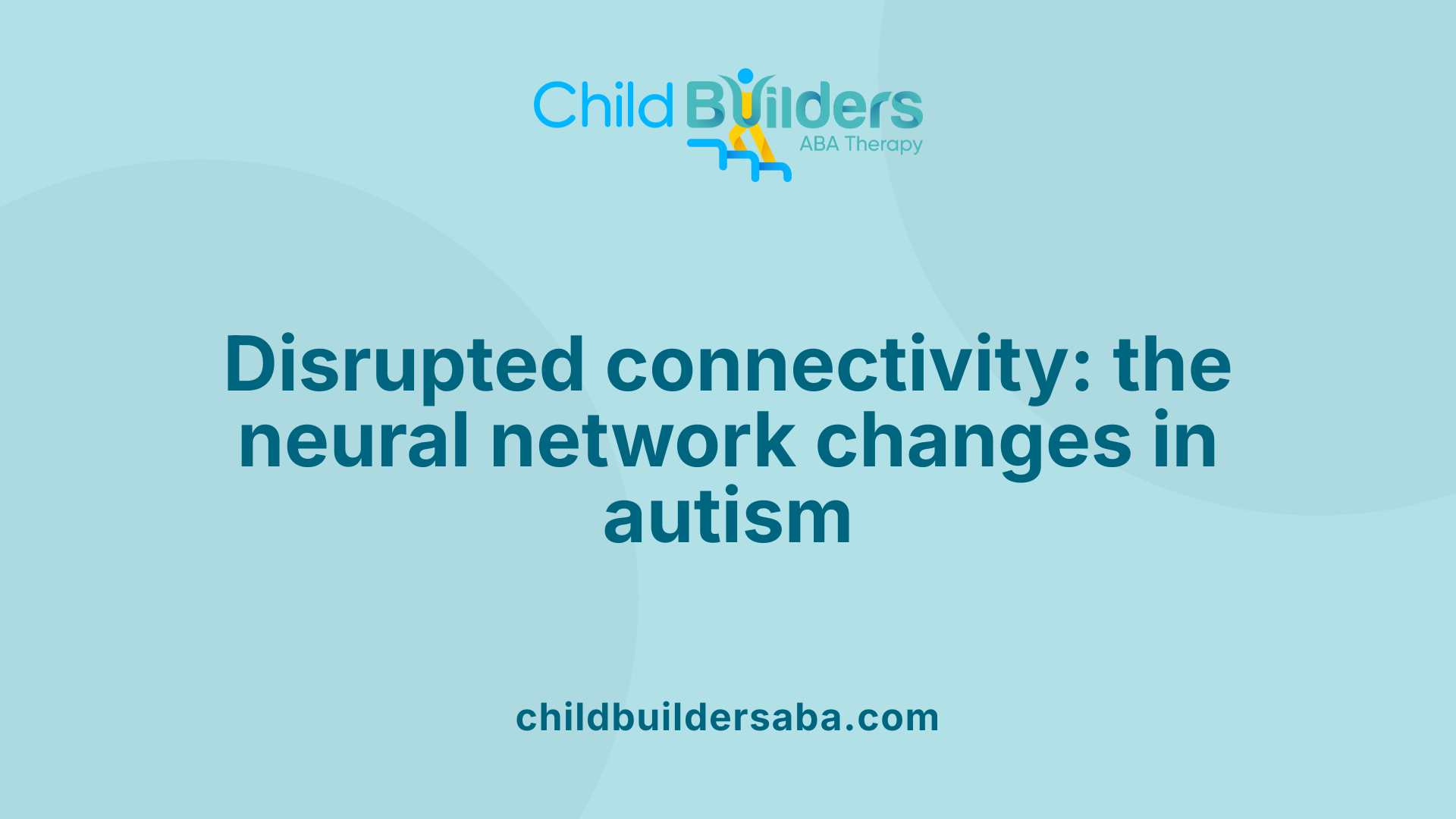
What does neuroimaging research reveal about the brains of individuals with autism?
Neuroimaging studies have provided substantial insights into the structural and functional differences in the brains of those with autism spectrum disorder (ASD). These investigations, utilizing tools like MRI (Magnetic Resonance Imaging), DTI (Diffusion Tensor Imaging), and fMRI (functional MRI), have identified a range of atypical brain features that underpin the behaviors associated with autism.
One prominent finding is the presence of abnormal connectivity patterns. Specifically, many individuals with ASD exhibit long-range hypoconnectivity, meaning that communication between distant brain regions like the frontal and temporal lobes is reduced. This reduced integration affects higher-order cognitive processes, social understanding, and emotional regulation.
Conversely, local hyperconnectivity—an increase in connection density within nearby regions—has been observed especially in sensory and motor areas. This heightened local connectivity may contribute to the sensory hypersensitivity and repetitive behaviors often seen in autism.
Neuroimaging also reveals significant abnormalities within large-scale brain networks. Key among these are the default mode network (DMN) and the salience network. The DMN, which is active during rest and involved in self-referential thought, often shows decreased connectivity in ASD, correlating with social and communicative difficulties. Similarly, the salience network, responsible for identifying important stimuli and switching between other networks, displays altered activation patterns, impacting social interactions and attention.
Structural changes further support these functional findings. Variations in grey matter and white matter volumes are common, with some regions enlarging while others are reduced, depending on age and specific brain areas. For example, early brain overgrowth has been documented, especially in the first two years of life. White matter tract abnormalities, such as in the corpus callosum and fronto-occipital fasciculi, disrupt the typical wiring of the brain, affecting information flow between different regions.
These neuroimaging findings do not exist in isolation. They are often linked with genetic data showing associations with specific risk genes that influence brain development and connectivity. Overall, these comprehensive neuroimaging results reinforce the understanding that ASD involves complex, age-dependent disruptions in both brain structure and network function, which form the biological basis of its core features.
Genetic and Molecular Foundations of Neuroanatomical Variations
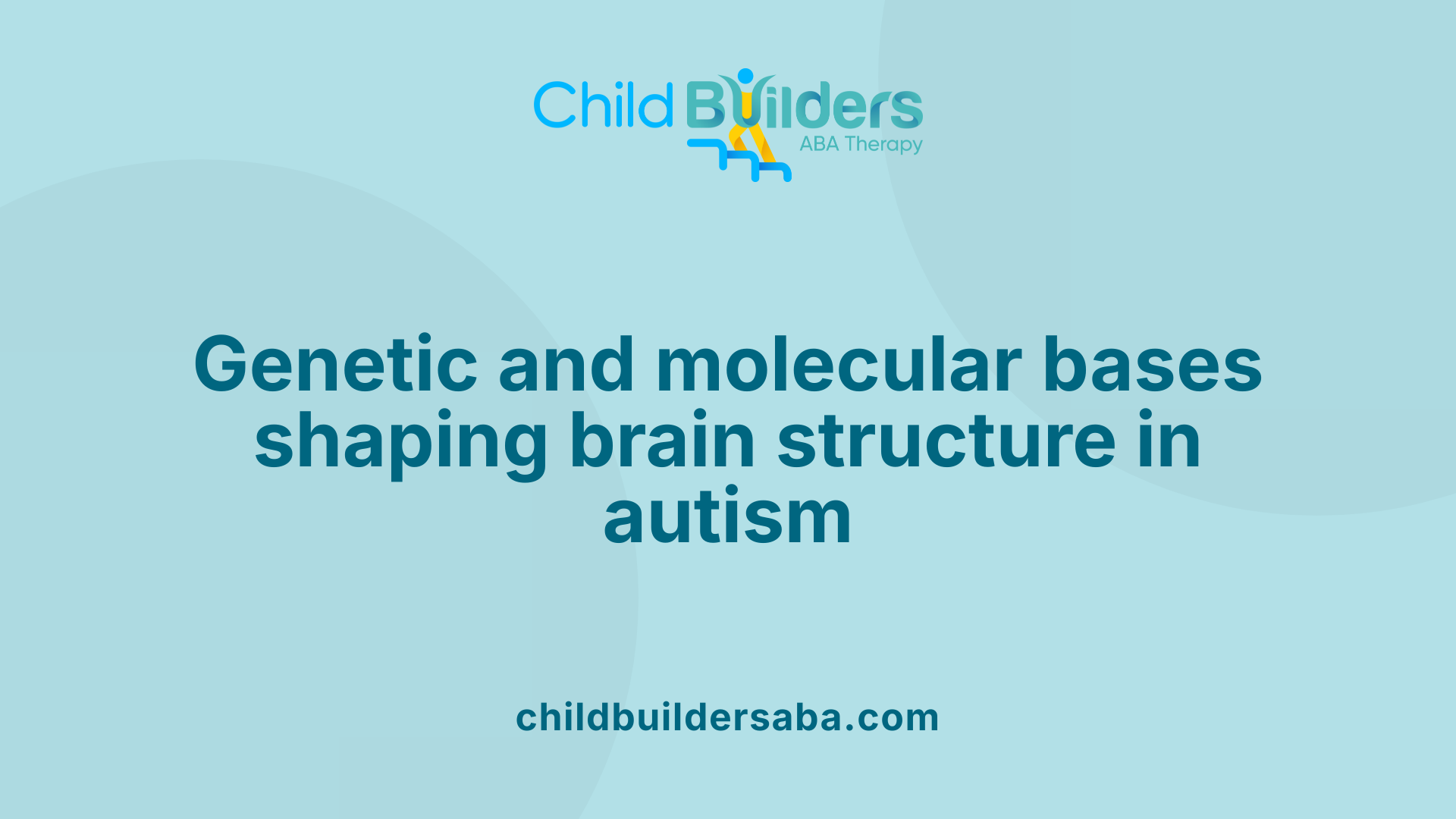
What are the neurobiological and structural brain differences associated with autism?
Research into autism has uncovered significant variations in brain structure and neurobiology that help explain some of the behavioral and cognitive features of the disorder. One prominent aspect is the abnormal pattern of brain growth during early childhood. Studies have shown that children with autism often experience an early phase of brain overgrowth, particularly within the first two years of life, affecting the cerebral, cerebellar, and limbic structures. This overgrowth is connected to an expansion of cortical surface area, especially in regions like the frontal and temporal lobes, which play key roles in higher-order cognition, social interaction, and language.
Following this rapid early growth, many children with autism demonstrate an arrest or slowdown in brain development, leading to atypical cortical thinning or thickening depending on the specific brain region and age. For example, abnormalities in the amygdala, a region integral to emotional processing, are characterized by initial enlargement during early childhood, then a deviation in size and connectivity as age progresses. Additionally, neuroimaging reveals smaller white matter volume and altered cortical thickness across different brain regions, along with microstructural changes detected via diffusion tensor imaging (DTI). These alterations suggest disrupted connectivity in neural circuits associated with social cognition, language, and sensory processing.
Structural abnormalities extend beyond size and thickness to include changes in neuronal organization. Postmortem brain studies have identified decreased cell size and increased cell density in the hippocampus, amygdala, and limbic system. Enlarged neurons have also been observed in cerebellar nuclei and the inferior olive. Such neuroanatomical disparities are linked to the core features of ASD, including social deficits, repetitive behaviors, and sensory abnormalities.
Moreover, neurobiological differences are influenced by specific genetic variations. Variants in genes such as HOXA1, PTEN, NL3, SHANK3, and 16p11 are associated with brain overgrowth, altered cortical development, and regional structural differences. For instance, mutations in HOXA1 relate to macrocephaly, while PTEN mutations are connected to increased brain volume. These genetic factors influence neurodevelopmental pathways critical for synaptic formation, neuronal migration, and cell signaling.
Neuroimaging studies also demonstrate disrupted connectivity within key brain networks. Functional MRI (fMRI) and resting-state analyses highlight decreased long-range connectivity in networks involved in social information processing, such as the default mode network (DMN), as well as increased local connectivity, which might relate to repetitive behaviors.
Overall, a complex interplay between genetic factors and neurodevelopmental processes results in the neurobiological and structural brain differences observed in individuals with autism. These variations underpin many of the clinical features and cognitive diversity seen across the spectrum.
Genes involved in brain structure and function
Genetic research has identified several genes implicated in the neuroanatomical features of autism.
| Gene | Role in Brain Structure/Function | Associated Structural Changes |
|---|---|---|
| HOXA1 | Regulates early brain patterning, impact on head size | Macrocephaly, increased head circumference |
| PTEN | Tumor suppressor gene involved in cell growth and proliferation | Brain overgrowth, macrocephaly |
| SHANK3 | Synaptic scaffolding protein affecting connectivity | Altered cortical thickness, synaptic irregularities |
| 16p11 | Chromosomal region linked to synaptic function and growth | Brain volume variations, regional overgrowth |
| NL3 | Modulates inhibitory neurotransmission | Changes in GABA signaling, balance of excitation and inhibition |
These genetic factors influence the development, layout, and connectivity of brain regions, contributing to the structural variations seen in autism.
Gene expression patterns and their impact on development
Studies analyzing gene expression in autistic brains have revealed widespread changes that affect neurodevelopmental pathways. Researchers examined postmortem tissues from individuals aged 2 to 73 years, focusing on the superior temporal gyrus, a region involved in processing sounds, language, and social cues.
They identified 194 genes with significant differential expression: 143 were upregulated, and 51 were downregulated in autistic brains. Notably, immune response and inflammation-related genes showed increased expression, with heat-shock proteins elevated, indicating immune activation. This pattern suggests that immune dysfunction and neuroinflammation are integral to autism pathology.
Concurrently, genes involved in GABA synthesis displayed decreased expression with age, impacting inhibitory neurotransmission crucial for neural circuit stability. Altered signaling pathways, such as insulin-mediated pathways, have also been observed, with some molecular patterns resembling neurodegenerative diseases like Alzheimer’s.
Specific gene alterations impact neural connectivity and stress responses, affecting how neurons communicate and adapt over time. For example, the gene HTRA2 shows increased expression with age, potentially influencing mitochondrial function and neuronal health.
Inflammation, immune response, and neurotransmitter alterations
Increased expression of immune-related genes suggests that neuroinflammation is a significant factor in autism. Excessive or dysregulated immune activation during critical developmental periods can interfere with normal neural circuit formation.
The persistent activation of heat-shock proteins points to ongoing cellular stress responses, which might modify neuronal growth and synapse integrity. Additionally, decreased GABA synthesis gene expression reduces inhibitory signaling, contributing to neural hyperexcitability observed in autism.
Alterations in insulin signaling pathways also suggest metabolic disturbances affecting brain growth and neuronal function. These molecular changes are not isolated but part of a broader network involving immune, neurotransmitter, and metabolic systems, possibly explaining the heterogeneity of autism symptoms.
Understanding how these genetic and molecular factors influence brain structure offers valuable insights into potential therapeutic targets. Interventions aimed at modulating immune activity, restoring neurotransmitter balance, or adjusting growth pathways could be promising avenues for future research.
Emerging Therapeutic Approaches Based on Neurobiological Insights
What are the neurobiological and structural brain differences associated with autism?
Research has shown that autism involves extensive differences in brain structure and function. These differences are not limited to specific regions but are widespread across the cerebral cortex. Structural anomalies such as early brain overgrowth during the first two years of life are common, with an accelerated expansion of cortical surface area before age 2, primarily affecting the frontal, temporal, and parietal lobes.
Following this rapid overgrowth, many individuals experience a slowdown or arrest in brain growth. Such deviations occur during critical windows when neural circuits are highly plastic but vulnerable to disruptive influences. This abnormal growth pattern is linked to the enlargement of certain regions like the cerebellum and limbic structures, including the amygdala and hippocampus, which play roles in social, emotional, and cognitive functions.
Neuroimaging studies further reveal altered patterns of brain connectivity in autism. There is evidence of long-range hypoconnectivity—meaning distant brain regions communicate less effectively—paired with local hyperconnectivity within specific areas. Functional MRI (fMRI) highlights dysfunctional activity in social cognition networks, including the right inferior frontal gyrus, superior temporal sulcus, and amygdala, impacting social communication.
Microstructural white matter changes, such as in the anterior thalamic radiation and fronto-occipital fasciculi, also indicate atypical neural wiring. These connectivities influence sensory processing, language, and social behaviors. Variations in cortical thickness and gyrification pattern abnormalities, like increased folding in the frontal and temporal regions, further support the view of widespread neural disruption.
Genetic studies complement these findings by associating specific gene variations with brain morphology alterations. Genes involved in synaptic functioning, immune response, and neurodevelopment—such as SHANK3, PTEN, and 16p11.2—are linked to structural brain differences, emphasizing the genetic-neuroanatomical interplay.
Overall, autism results from a combination of early brain overgrowth, disrupted connectivity, and genetic factors, leading to the diverse phenotype and the challenges faced in social, emotional, and cognitive domains.
Potential targets in brain connectivity and synaptic regulation
Understanding how neural circuits are wired and function in autism opens avenues for targeted interventions. Abnormal connectivity patterns suggest that modifying synaptic activity could normalize brain function.
One promising target is the regulation of synaptic plasticity—the brain's ability to strengthen or weaken connections. Therapies aimed at modulating synaptic activity, such as pharmacological agents influencing glutamate and GABA neurotransmission, are under investigation.
Studies measuring synaptic density directly in living individuals, using advanced imaging like PET scans with novel radiotracers, show that autistic adults have approximately 17% lower synaptic density than neurotypical peers. This reduction correlates with social-communication impairments and autistic traits, suggesting that restoring synaptic balance might improve behavioral outcomes.
Additionally, abnormal activity patterns in sensory and social regions, including the temporoparietal junction involved in social perception, suggest potential biomarker targets. Techniques like transcranial magnetic stimulation (TMS) could modulate neural activity in these regions, potentially enhancing social cognition.
Rebalancing neural circuits by promoting appropriate connectivity is a key focus. Strategies involving neurofeedback, neuromodulation, and pharmacotherapy aim to optimize neural synchrony and improve integration across brain networks.
Gene and molecular targeted interventions
At the molecular level, autism-associated gene expression profiles reveal disruptions in pathways related to immune response, inflammation, and neurotransmitter systems. Increased expression of heat-shock proteins indicates immune activation, while decreases in GABA synthesis genes with age point to inhibitory neurotransmission deficits.
Gene-targeted interventions could correct or compensate for these molecular abnormalities. For example, modulating immune response through anti-inflammatory agents or targeting specific genes like NRXN1 or SHANK3—which encode synaptic proteins—might restore proper synaptic function.
Researchers are exploring gene therapy approaches to address these molecular deficits. While still in early stages, such interventions hold promise, especially if delivered during critical developmental windows.
Furthermore, understanding immune dysfunction in autism suggests anti-inflammatory treatments or immune-modulating therapies could help mitigate neurodevelopmental disruptions caused by prenatal or early-life inflammation.
Early intervention strategies and the importance of critical periods
The timing of intervention is crucial given the brain's heightened plasticity during early childhood. The first two years represent a window when brain overgrowth and synaptic formation are most prominent.
Early behavioral therapies, including applied behavior analysis (ABA), focus on improving social and communication skills during these critical periods. Recent neurobiological insights underscore that early intervention can potentially influence brain connectivity patterns, possibly redirecting typical developmental trajectories.
Additionally, combining behavioral therapies with neurostimulation or pharmacological treatments during these windows may amplify benefits. Addressing neurochemical imbalances or abnormal gene expression early on could prevent or reduce the severity of symptoms.
In conclusion, understanding the neurobiological foundation of autism—from structural brain differences to molecular regulation—paves the way for innovative therapies. Targeting neural circuits, gene function, and neurodevelopmental timing holds promise for more effective and personalized interventions in the future.
Conclusion: Toward a Neurobiological Framework for Autism
What does neuroimaging research reveal about the brains of individuals with autism?
Neuroimaging studies have provided crucial insights into how the brains of individuals with autism differ from neurotypical development. These investigations have consistently shown both structural and functional anomalies across various brain regions.
Structurally, children with ASD often experience early brain overgrowth, particularly between ages 2 and 4, involving the cerebral cortex, cerebellum, and limbic structures. This rapid growth phase is followed by slower or arrested development, which persists through adolescence and adulthood. MRI and diffusion tensor imaging (DTI) have revealed abnormal volumes in grey and white matter, with some regions like the amygdala and hippocampus showing altered size and cell density. Increased cortical folding in specific areas, such as the frontal and temporal lobes, has also been observed, reflecting changes in neuronal network formation.
Functionally, individuals with autism show atypical activation patterns during social and emotional tasks. Resting-state fMRI highlights alterations in large-scale brain networks such as the default mode network and salience network, which are involved in self-referential thought, social cognition, and attention. Disrupted connectivity—both reduced long-range communication and increased local hyperconnectivity—appears to impair information integration across different brain areas.
The temporal dynamics of neural activity are also affected, with notable abnormalities in synchronization and timing, particularly in regions critical for social perception like the amygdala, superior temporal sulcus, and temporoparietal junction. These regions often demonstrate decreased activity when processing social cues, such as emotional speech, correlating with observed social communication difficulties.
Genetic factors intertwine with neuroimaging findings. Variations in genes associated with neural development, inflammation, neurotransmitter function, and synaptic regulation—such as SHANK3, PTEN, and 16p11—are linked to specific structural and connectivity changes observed via imaging. For example, mutations affecting the organization of the corpus callosum or cortical thickness contribute to the neuroanatomical heterogeneity of ASD.
In addition to structural and functional differences, evidence points to neurochemical alterations, including changes in GABAergic and glutamatergic systems, as well as immune-related mechanisms. These neurobiological factors can influence neural circuitry and plasticity, ultimately affecting cognitive and behavioral profiles.
Overall, neuroimaging research underscores that autism is a disorder rooted in atypical neurodevelopment. It involves complex changes in brain growth trajectories, neural connectivity, and network organization, which manifest as the core social, communicative, and behavioral symptoms.
Implications for diagnosis and treatment
Understanding these neurobiological patterns has significant implications. Early detection might be enhanced by identifying biomarkers in brain structure or activity that precede or coincide with behavioral symptoms. For example, monitoring abnormal growth patterns, connectivity markers, or electrophysiological signatures could facilitate earlier or more precise diagnosis.
Therapeutically, interventions targeting neural connectivity—such as neurostimulation techniques like transcranial magnetic stimulation (TMS), neurofeedback, or pharmacological approaches—aim to normalize disrupted circuits. The insights into neurotransmitter system alterations also open avenues for developing targeted medications to modulate excitatory-inhibitory balance.
Furthermore, personalized medicine approaches integrating genetic, neuroimaging, and behavioral data hold promise for tailoring interventions to individual neurobiological profiles, potentially improving efficacy.
Future research directions
Moving forward, a comprehensive understanding of autism's neurobiology will require longitudinal studies tracking brain development from infancy through adulthood. This will help clarify how early structural and connectivity anomalies relate to later behavioral outcomes.
Advances in multi-modal imaging, coupled with genomics and electrophysiological techniques, can unravel the multilayered complexity of ASD. Exploring how environmental factors, like neurotoxins or prenatal exposures, interact with genetic vulnerabilities remains critical.
Research focusing on neural plasticity and the potential for early intervention to modify developmental trajectories could transform therapeutic strategies. In addition, developing reliable biomarkers for early detection and monitoring treatment response will be essential.
By integrating neuroimaging findings with molecular and clinical data, future studies can refine our understanding of autism as a neurodevelopmental disorder, leading to better diagnostic tools and more effective, individualized therapies.
Harnessing Neurobiological Insights for Better Outcomes
Continued research into the neurobiological and structural differences in autistic brains offers promising avenues for early diagnosis, targeted therapies, and intervention strategies. By understanding the intricate network disruptions, gene expression alterations, and developmental timing of these changes, clinicians and scientists can develop more effective approaches to managing and supporting individuals on the autism spectrum. As neuroimaging and molecular studies advance, a neurobiological framework for autism will inevitably lead to personalized interventions, improving quality of life and functional outcomes for affected individuals.
References
- Brain changes in autism are far more sweeping than ... - UCLA Health
- Characteristics of Brains in Autism Spectrum Disorder: Structure ...
- Autism Spectrum Disorder: Autistic Brains vs Non ... - Health Central
- Brain development in autism: early overgrowth followed ... - PubMed
- Autism: Causes, Symptoms, & More | American Brain Foundation
- Brain wiring explains why autism hinders grasp of vocal emotion ...
- Autism spectrum disorder - Symptoms and causes - Mayo Clinic
- A Key Brain Difference Linked to Autism Is Found for the First Time ...
- How does autism affect the brain? | eLife Science Digests





































































































